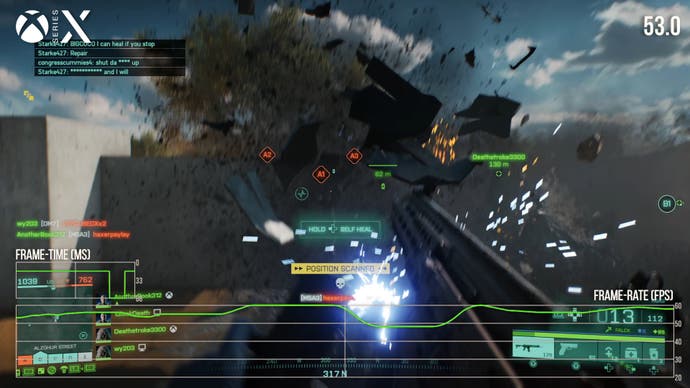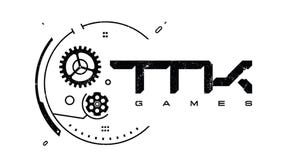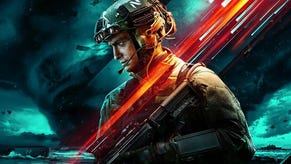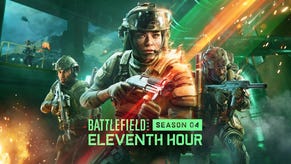Battlefield 2042 is coming together - but it still needs work
The latest builds tested on PS5 and Xbox Series consoles.
After a pair of entries that saw the Battlefield series revisit World Wars past, Battlefield 2042 is a trip back to the future for EA's premier first-person shooter franchise. Low-tech battles in European locales are out, replaced with massive, highly vertical conflicts in the megacities of the near future. With huge maps, a completely overhauled class system and an intriguing new 'portal' mode, Battlefield 2042 is an undeniably ambitious entry. Is this the next generation in Battlefield action? Perhaps not - it's a cross-gen game at its heart but the scale of combat expands with the move to the new consoles with a doubling of player count - 128 combatants vs last-gen's 64, resulting in absolute mayhem in some scenarios - but can PS5, Series S and Series X handle it? The results are much improved over beta and early access code, but there's still work to do.
Of course, we've seen gigantic player counts before with the battle royale genre routinely breaking past 100 concurrent users, but Battlefield 2042 is different. The sheer density of players here can result in some stunning, extraordinary scenes, particularly in the Breakthrough game mode, where all players fight over a small number of objectives. The carnage is intense and it's safe to say that you won't get scenes like this in Call of Duty's Warzone, for instance - it's completely different as players are too spread out. As the all-out mayhem plays out in front of you, some scenes need to be seen to be believed.
But perhaps the most interesting addition here is the new portal mode. This allows you to create custom games based on maps from Battlefield 2042, as well as prior Battlefield titles. There are six additional maps in this mode, consisting of recreations of maps from Battlefield 1942, Bad Company 2, and Battlefield 3. These new portal maps are paired with a range of options to customise your experience, including a rudimentary game logic editor. It's somewhat reminiscent of Halo's Forge, albeit with less map customisation with more scope for tweaking game modes and player abilities.
It's a great addition but the presentation feels a little odd. Consigning these six maps to community servers with custom game types and no progression rewards is quite limiting. It feels especially odd given that almost half of Battlefield 2042's 13 maps are exclusive to this mode. Surely, these maps should be part of the main game in a more substantial way - perhaps their own playlist. Still, it's a welcome inclusion, particularly for players who have spent countless hours playing prior Battlefield titles. What this title does lack is a campaign mode, but considering the volume of multiplayer content, I don't think it's a huge loss.
In terms of technology, Battlefield as a series has always pushed boundaries and 2042 follow suit. The Frostbite engine still looks impressive, featuring massive playable areas with lots of geometry, great PBR materials, beautiful lighting and impressive particle effects. The chaos here is often stunning. So beyond player counts, what does next-gen bring to the table beyond increases in resolution and frame-rate? Lush, abundant foliage is a stand-out feature, while weather systems can look spectacular, featuring massive, map-changing storms, with tornadoes, sand gusts, and rain swells. The GPU particle system first used in Battlefield 5 gets a great workout, adding all sorts of dust and dirt particles that get thrown around by the wind and collide with the environment.
Finally, screen-space reflections are also present here, for the first time in a console Battlefield game. No, there's no ray tracing at hand, but we do see some reasonable looking reflections in general play - an improvement from prior Battlefield titles on console which relied exclusively on cube-maps. These do tend to look a little messier than in many other titles however, as they exhibit noticeable halo artefacts where they intersect with scene geometry.
The general impression is that fidelity has not taken a huge leap from Battlefield 5 on last-gen consoles, although there are substantial visual enhancements and a very welcome increase in scope. Some maps also look a little boxy and plain, owing to large concrete areas with little in the way of clutter, though this seems like more of a gameplay decision than a technical one. Some players may be disappointed that we haven't seen a ray tracing implementation here or 120fps support. I do feel like this is a fair trade-off for the enhancement to map size and player count, although those features do seem to carry a frame-rate cost as well.
Performance-wise, there's the sense that frame-rate isn't quite where it should be, particularly in the new 128-player modes. In terms of resolution, both PlayStation 5 and Series X target 4K at 60 frames per second, dropping to 1800p in busy scenes (a wider DRS window can't be ruled out, of course, but that's where the counts took us). By and large though, drops from the target resolution are relatively rare - they both turn in a sharp and stable image that looks great on a 4K display. Series S? It seems to vary between 1080p and 1296p based on my tests, with the junior Xbox presenting a blurrier image and some reductions to effects like foliage density.
Performance tends to vary according to player count. The modes with 64 players and below, such as hazard and portal modes, seem to run great on all current-gen platforms. On Series X, S, and PS5 the readout is 60fps on each console with only occasional single frame dips, essentially undetectable in the run of play. These modes feel great to play, though the scope is much smaller than the 128-player mayhem of the main game - and it's here where we have problems, with all consoles dropping performance in intense battles, particularly with many players present or when flying aircraft. On PS5 and Series S these problems aren't too bad - there's generally a pretty solid 60fps with occasional dips. It's not ideal, but it's very playable and these problems are not a major impediment to the experience. At its lowest, we see readouts in the low to mid 50s during more intense gameplay. There's some occasional stutter on all consoles, though it seems worst on Series X: 50ms pauses occur regularly, although these can last for hundreds of milliseconds at worst.
Thankfully, there is a sort of solution to the performance problems, if you can accept some compromises. You can download the Xbox One and PS4 versions on the PS5 and Series consoles and enjoy a nigh-on faultless 60fps experience in the large player count modes, although you only get a maximum of 64 players on these versions. Unlike most Xbox Series titles it is possible to download and play the base Xbox One version of the game here, even if you have purchased the Series version - presumably to allow Series owners to hang out with friends who've not yet upgraded to the latest and greatest machines. The graphical downgrade isn't too bad, though you do miss out on the enhanced foliage and hi-res textures of current-gen, as well as screen-space reflections, hi-res shadows and a handful of other improvements. The maps, while smaller, do still manage to feel a little empty with 64 players.

Unfortunately, it is not currently possible to select 64-player versions of these maps on the native Xbox Series and PS5 versions of the game, which would likely fix the performance issues experienced in 128-player mode. It's a bit of shame that we couldn't simply get reduced player count versions of the existing maps implemented on current-gen, but this is the way to play for now if you're looking for improved performance. It's not an easy choice - you trade some graphical and gameplay features for a locked frame-rate. As an aside, it would be nice to see this implemented for non-performance reasons as well. Smaller versions of the maps with smaller player-counts and different match types were present and enjoyable in prior Battlefield games, and it's odd that they haven't been included here - the performance issues just make the demand that much more urgent.
I did notice one other performance issue on all consoles, however, and it's a problem that Battlefield players are all too familiar with. This is the issue of "rubber-banding", a sort of movement-related network sync stutter that has been present to some degree in Battlefield titles stretching back to Battlefield 3. Here, it presents as a persistent stutter on player movement during some matches. It's quite annoying and feels similar to a frame-time spike, although the frame-rate doesn't actually drop - your character just momentarily pauses. This seems to come and go on an unpredictable basis in my testing on a gigabit wired connection, although your experience may differ depending on connection quality.
There are noticeable bugs in the current build as well. Thankfully, these are mostly fairly minor issues and visual quirks. Your load-out options sometimes disappear on the spawn screen, for instance, and sometimes I got match-made into lobbies where it was impossible to spawn into gameplay. There are also some occasional quirks with player physics, though this won't come as a surprise to long-time Battlefield players. Hopefully, these performance issues can be ironed out soon.
Until then, I'd consider Battlefield 2042 as a relative success that just requires some additional level of refinement: the visuals here are attractive, if decidedly cross-gen, and the increase in player count feels like a real accomplishment. Performance is another story, but the current-gen consoles aren't too far off the mark in frame-rate terms. Network stability, bugs, and frame-time spikes all need some attention however, although these issues seem eminently patchable. With all of this in mind, there is the sense that Battlefield 2042 is a patch or two away from addressing its major issues, at which point, it would be well worth checking out.


















